Metamorphic minerals in thin section
Mostly not seen previously for igneous rocks
| Mineral types |
Al-silicates Other aluminous minerals Amphiboles Pyroxenes Sheet silicates Epidote group Oxides |
|---|
Remember that all of the igneous minerals can also occur in metamorphic rocks. Those shown here are either rare or absent in igneous rocks, the minerals look somewhat different because of their metamorphic petrogenesis, or if I just like them. Many of the images have two views, most showing paired plane- and cross-polarized light images. Move the cursor over the visible image to see the other view.
火成岩の鉱物は変成岩でも見られることは思い出してほしい.ここで示すのは,火成岩には見られないか,珍しいものを示す.そして鉱物は変成作用ゆえに少し異なっていたりする.多くの画像はPPLとXPLの2枚の画像を持つ.カーソルを動かすと他の画像が見える.
| Al-silicates | |
 |
 |
| Andalusite in a
muscovite–biotite schist. Note the diamond-shaped inclusion cloud to the
bottom left, at the crystal center, and the inclusion trails that
radiate from the corners of the diamond. This is known a "chiastolite
cross". Note the small garnet just below the diamond. Two {110}
cleavages intersecting at approximately right angles are visible.
Andalusite has lower relief than the other Al-silicates. Birefringence
is first order white to pale yellow, much like quartz and feldspars but
with higher relief and very different habit. In cross-polarized light
the garnet is clearly isotropic garnet. Plane/cross-polarized light, field width is 6 mm. NEIGC84-C5-2 |
両雲母片岩中の紅柱石.
下左にあるダイヤモンド型の包有雲,そしてその角がから流れ出る包有物は「空晶石」の十字と言われる.ダイヤモンドの直下に小さなざくろ石が見えることに
注意(XPLで等軸晶系).2つの直交する110へき開が見える.紅柱石は他のアルミ珪酸塩に比べ,低い輪郭(屈折率)を持つ.複屈折は一次の白から淡い
黄色で,石英や長石に似るが,より高い屈折率と異なった癖を見せる. PPL/XPL,視野幅6mm |
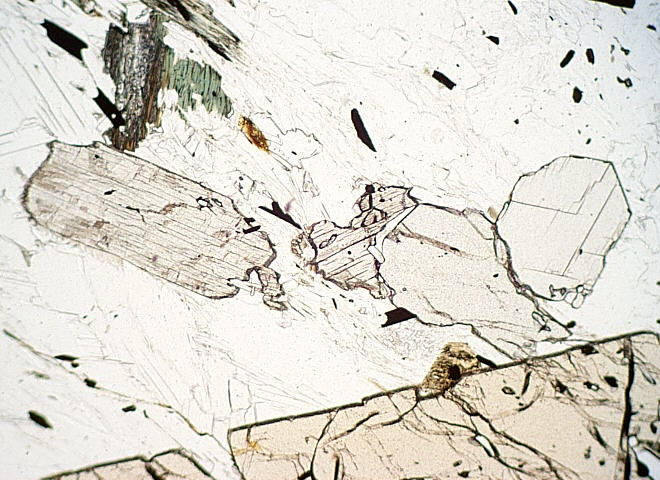 |
 |
| Kyanite in a muscovite–biotite
schist. The four kyanite crystals are colorless, have high relief, and
two have a strong cleavage parallel to their length. Relief is much
higher than muscovite, which surrounds the kyanite. The kyanite crystals
have interference colors up to upper 1st order, much lower than
muscovite. Most sections yield slightly inclined extinction, as expected
from its triclinic symmetry. Plane/cross-polarized light, field width is 3 mm. TMW96-C4b |
両雲母片岩中の藍晶石.4
つの藍晶石の結晶は無色で,高い屈折率を示し,長方向に平行な強いへき開を持つ.白雲母より高い屈折率のために,輪郭が浮き上がってみえる.藍晶石の結晶
は白雲母よりも低い1次の上までの干渉色を持つ.多くの断面では三斜晶系から期待される,わずかに傾いた斜消光を示す. PPL/XPL,視野幅3mm |
 |
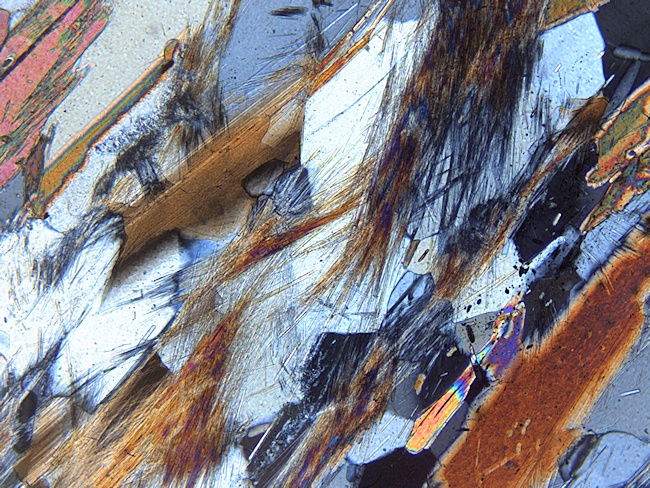 |
| Sillimanite fibers (variety
fibrolite), in a biotite–sillimanite–muscovite schist. Sillimanite is
colorless, and has relief much higher than muscovite. In medium-grade
rocks sillimanite is typically of this fibrous variety. Sillimanite
fibers can be included in many minerals, and can survive retrograde
metamorphism in garnet and quartz. Sillimanite has birefringence up to
2nd order blue, somewhat higher than kyanite and much higher than
andalusite. Extinction is parallel, as required by its orthorhombic
symmetry. These fibers are so thin that individual ones scarcely have
any birefringence, but thick stacks of them do. Plane/cross-polarized light, field width is 0.6 mm. JBT2-XA |
両雲母−珪線石片岩中の珪線石の
繊維(フィロバイトともいう).珪線石は無色で白雲母より高い屈折率を持つ.中くらいの変成度の石では,珪線石はこのような繊維状の様子を示す.そしてこ
の珪線石の繊維は多くの包有鉱物を含み,それらはざくろ石や石英の中の後退変成作用を生き延びる.珪線石の複屈折は2次の青で藍晶石より高く,紅柱石より
さらに高い.斜方晶系からくる直消光.これらの繊維は非常に細く,複屈折を持ちにくいが,厚くなるとそれを確認できる. PPL/XPL,視野幅0.6mm |
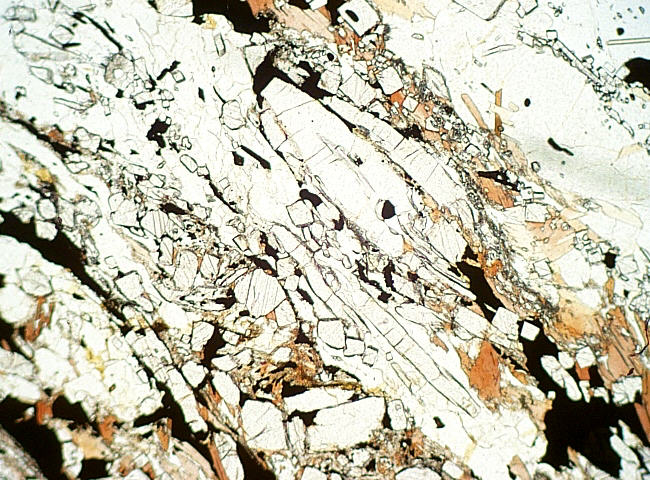 |
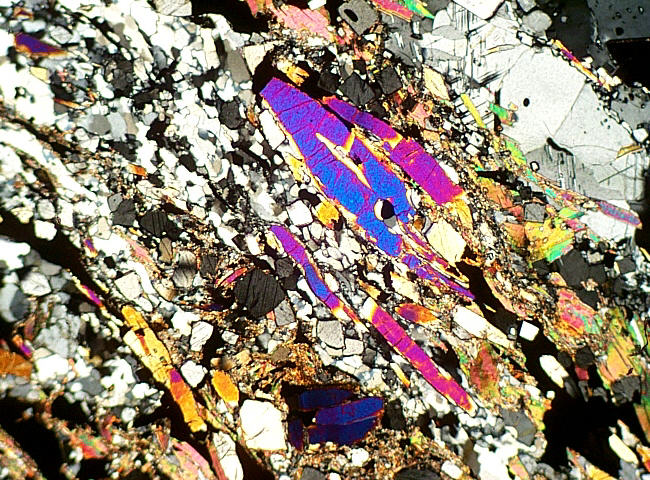 |
| Sillimanite prisms in a
biotite–garnet–cordierite schist. This granulite facies schist has
coarse sillimanite prisms that can be seen in long section and in their
diamond-shaped cross sections. The lower second order blue birefringence
can be seen in the long sections. Plane/cross-polarized light, field width is 3 mm. WE-1 |
黒雲母−菫青石片岩中の珪線石プリズム.このグラニュライト相の片岩の粗い珪線石プリズムは長軸断面とひし形断面が見れる.低い2次の複屈折の青が長軸断面に見られる. PPL/XPL,視野幅3mm |
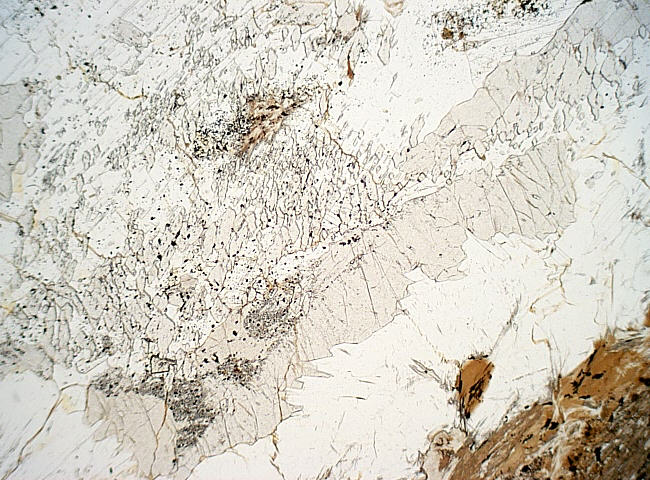 |

|
| Sillimanite and andalusite
together in a biotite–muscovite–andalusite schist. The large,
high-relief (grayish) patches are andalusite, which are surrounded by a
coarse muscovite rim. The andalusite is partially pseudomorphed by
sillimanite, which appears as high-relief, colorelss diamond shapes. In
cross-polarized light the andalusite mostly occupies the large gray
areas, and the sillimanite domains are the vertically elongated white
diamonds scattered throughout the upper-left half of the image. Plane/cross-polarized light, field width is 6 mm. JBT2-XA |
両雲母−紅柱石片岩における珪線石と紅柱石の
共存.大きな高い屈折率の灰色のパッチが紅柱石.そしてそれは粗い白雲母のリムに囲まれる.紅柱石は部分的に珪線石に仮像化されている.そしてそれは高い
屈折率の菱形をしている.XPLでほとんどの紅柱石は,広い灰色のエリアを覆い,珪線石部分は画像の上方左半分のエリアの,白い垂直に延びた菱形である. PPL/XPL,視野幅6mm |
| Other aluminous minerals | |
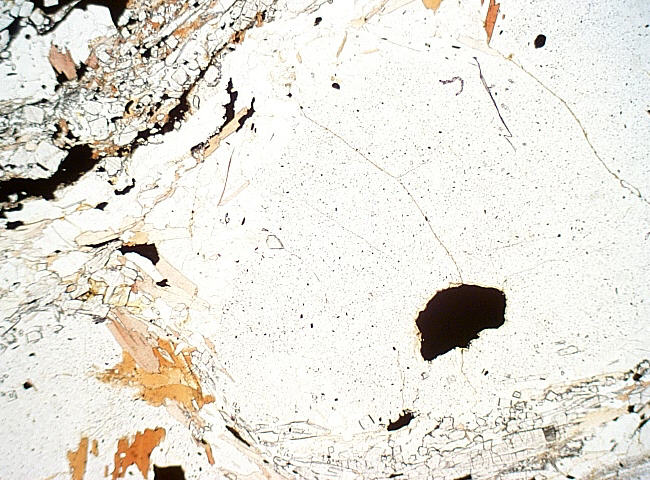 |
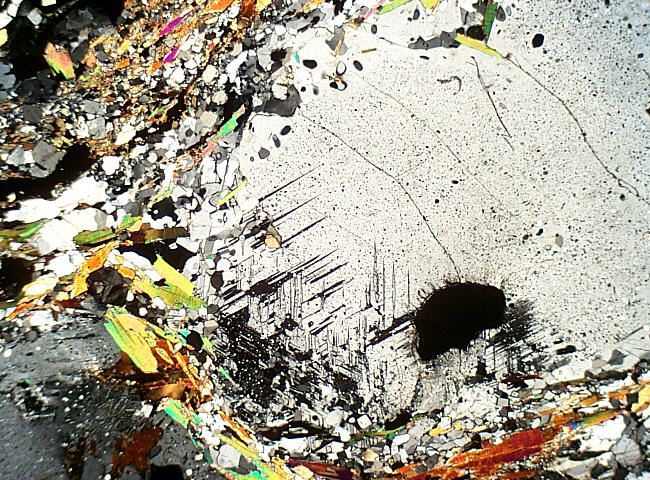 |
| Cordierite in a
garnet–cordierite–biotite schist. Cordierite is colorless, and relief is
similar to feldspar and quartz, but it tends to be dustier than either
of them. Why I don't know. Birefringence is up to 1st order white, like
feldspar and quartz, and can have polysynthetic twinning (center) that
resembles plagioclase. Note, however, that there can be THREE directions
of polysynthetic twinning in cordierite, contrasting with none in
quartz and typically one or two in feldspars Plane/cross-polarized light, field width is 3 mm. WE-1 |
柘榴石−菫青石−黒雲母片岩中の菫青石.菫青石は無色で屈折率は石英や長石に似ている.しかし菫青石はそのいずれもより,やや汚れた様子をしている.それがなぜかは知らない.複屈折は石英や長石と似た1次の白まで.中央部に斜長石に似た凝集性の双晶を持つ.しかし,特筆すべきは3つの双晶の方向を持つことで,これは石英にはなく,長石では1つか2つの方向にすぎない. PPL/XPL,視野幅3mm |
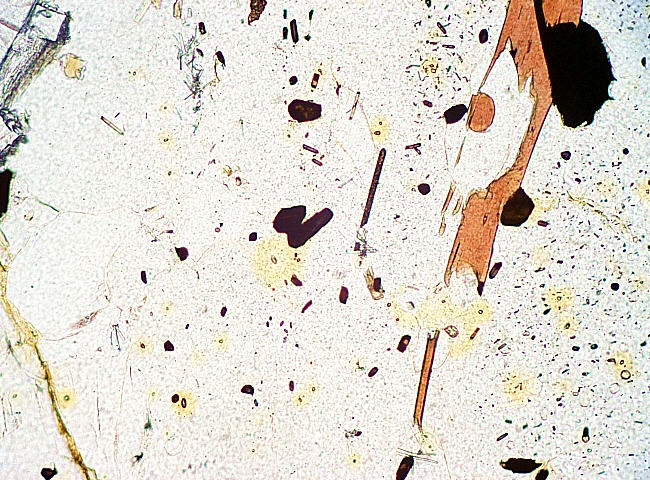 |
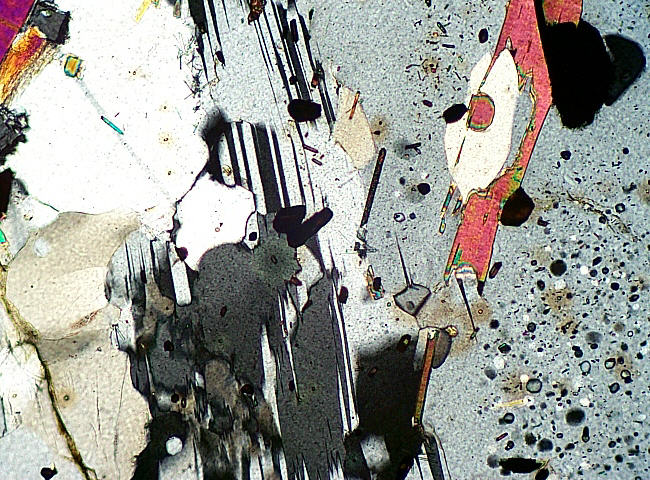 |
| Cordierite in a
garnet–cordierite–biotite schist. Enlarged view of pleochroic yellow
radiation halos surrounding radioactive inclusions. In cross-polarized
light the halos are typically brownish or purplish. Plane/cross-polarized light, field width is 0.6 mm. WE-1 |
柘榴石−菫青石−黒雲母片岩中の菫青石.多色性の放射性包有物を取り囲む黄色の放射ハロー.XPLではハローは典型的には茶色ないし紫色を呈する. PPL/XPL,視野幅0.6mm |
 |
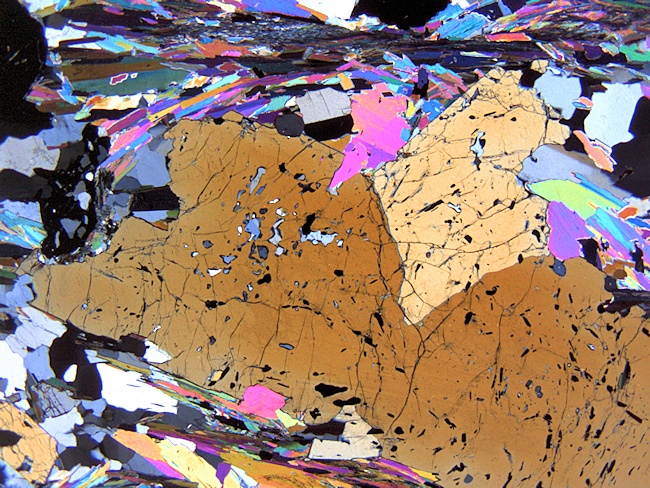 |
| Staurolite in a
muscovite–biotite schist. Staurolite has parallel extinction and one
cleavage parallel to its length, and has a characteristic pale to darker
golden yellow pleochroism. This example has a twin, highlighted by
different color and birefringence caused by its different orientation.
The birefringence of staurolite is similar to that of kyanite, upper 1st
order. Plane/cross-polarized light, field width is 6 mm. Gassetts Schist |
両雲母片岩中の十字石.十字石は直消光で長軸方向に平行な1つのへき開を持つ.そして特有の淡色から暗い黄金色の多色性を持つ.この例では双晶を持ち,異なる色で彩られ,また異なった方向の複屈折を生じる.十字石の複屈折は1次の上である藍晶石のものと似ている. PPL/XPL,視野幅6mm Gassetts Schist |
 |
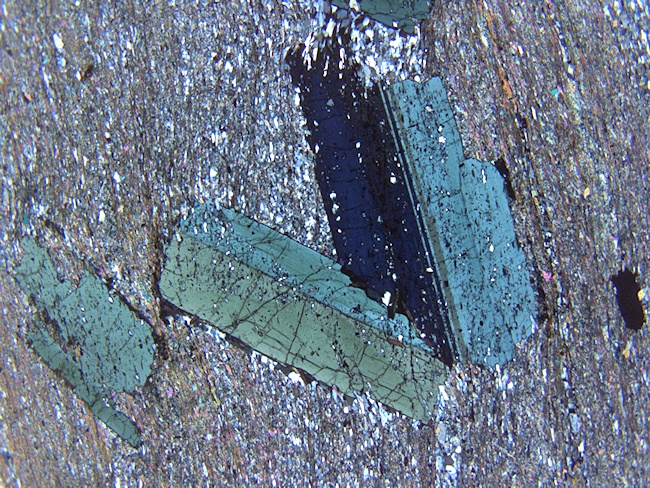 |
| Chloritoid in a
muscovite–chlorite phyllite. The pale blue to yellow pleochroism of the
chloritoid, and its high relief, contrasts sharply with lower relief,
pale yellow to green pleochroic chlorite. This chloritoid grain has
prominent twinning, evident in parallel stripes having somewhat
different pleochroic colors. The low first-order birefringence is
somewhat higher than that of most chlorite, but much lower than
muscovite. The polysynthetic twinning and somewhat anomalous first order
interference colors of chloritoid are visible in the cross-polarized
light image. Plane/cross-polarized light, field width is 6 mm. IMA96-C1-1 |
白雲母緑泥石千枚岩中のクロリトイド.クロリトイドの淡い青から黄色の多色性.そ
してその高い屈折率.このクロリトイドの粒は明瞭な双晶をしている.平行な縞模様はいくらか異なった多色性の色を帯びる.低次の1次の複屈折は緑泥石のも
のよりもいくらか高いが,白雲母よりははるかに低い.多対称性の双晶と,クロリトイドのいくらか異常な1次の干渉色がXPL画像に見える. PPL/XPL,視野幅6mm |
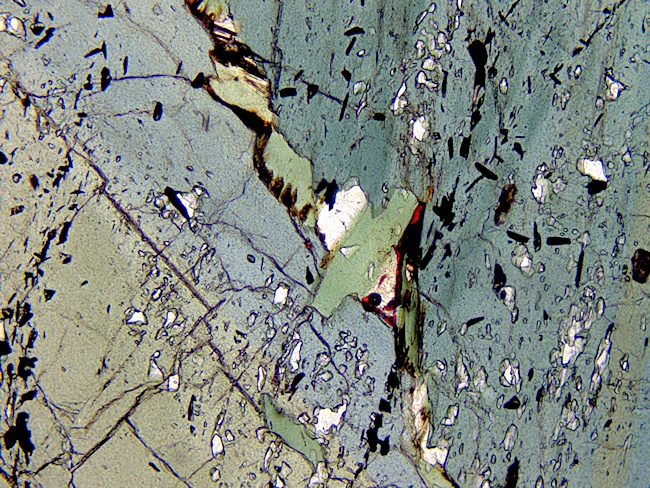 |
|
| Chloritoid in a muscovite–chlorite phyllite. Close-up showing green chlorite between bluer and much higher relief chloritoid. Plane-polarized light, field width is 1.2 mm. IMA96-C4B |
白雲母緑泥石千枚岩中のクロリトイド.青くより屈折率の高いクロリトイドの間の緑のクロリトイド. PPL,視野幅1.2mm |
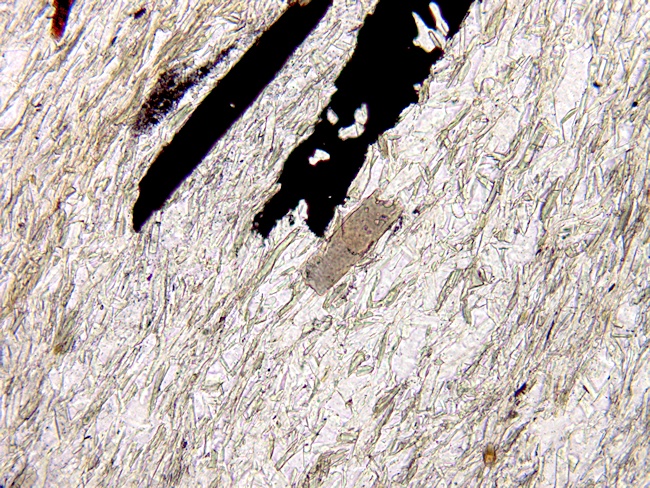 |
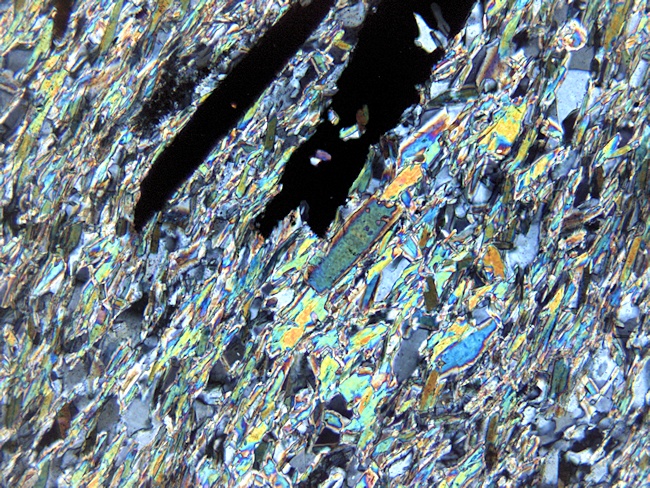 |
| Tourmaline in a
muscovite–biotite schist. Tourmaline occurs as elongate to stubby prisms
having hexagonal or triangular cross sections. They are typically zoned
in shades of blue, green, or brown. Tourmaline has no cleavage, though
cross fractures are common, and has negative elongation. Plane/cross-polarized light, field width is 0.6 mm. East Clairindon, VT |
両雲母片岩中の電気石.六角や三角の断面を持つ長いあるいはずんぐりした電気石.それらは典型的には,青,緑あるいは茶色の陰で縁取られる.電気石はへき開を持たず,クロスした破断が特徴.負の伸長性を持つ. PPL/XPL,視野幅0.6mm |
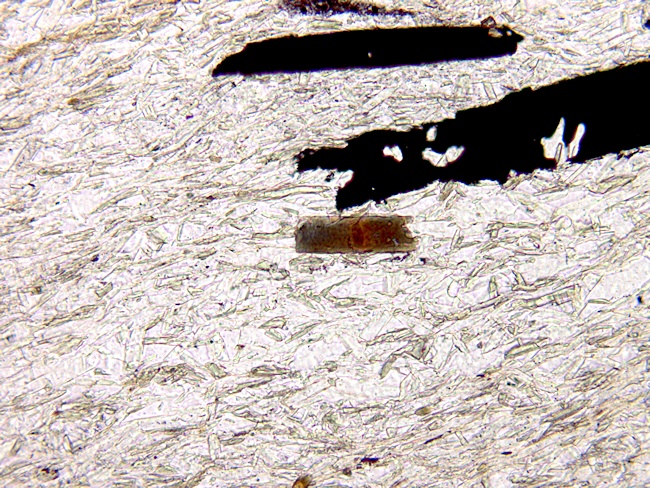 |
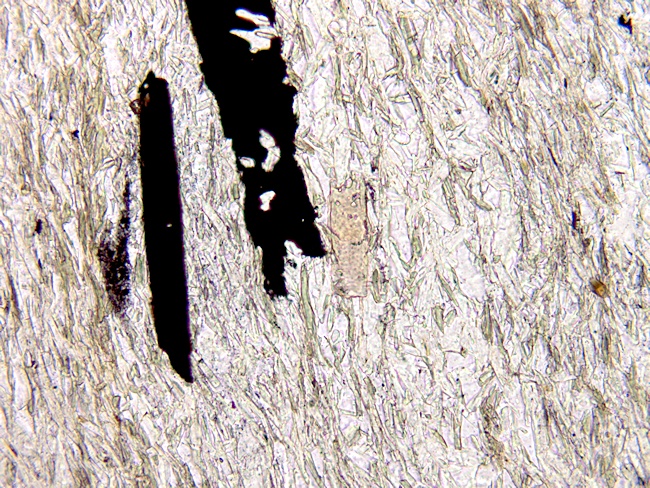 |
| Tourmaline in a
muscovite–biotite schist. These two images are of the same tourmaline in
the image centers, rotated 90° with respect to each other. Tourmaline
is unusual among common elongate minerals in having its strongest
absorption when the plane of light polarization is perpendicular to the
crystal length. This is the opposite the micas and most amphiboles. Both plane-polarized light, field width is 0.6 mm. East Clairindon, VT |
両雲母片岩中の電気石.これらの2つの画像は同じ電気石のたがいに90度回転させたもの.電気石は一般的な細長い鉱物の中では珍しく,光の偏光面が結晶の長さに垂直なときに最も強い吸収を示す.これは、雲母やほとんどの角閃石とは逆である. PPL/XPL,視野幅0.6mm |
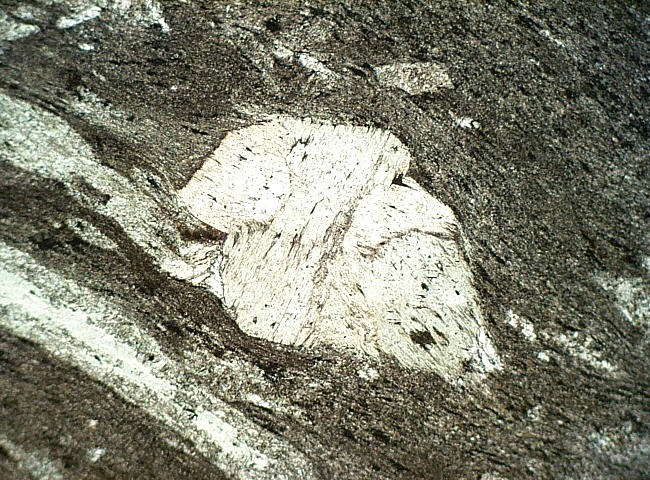 |
 |
| Actinolite in a greenstone.
These actinolite grains are very pale-green, and here occur as stubby
crystals. These are probably pseudomorphs after augite phenocrysts in
the basalt protolith. Like most monoclinic amphiboles actinolite has
birefringence in the lower 2nd order. Twinning, possibly relict from the
original augite, can be seen. Plane/cross-polarized light, field width is 3 mm. NNH-3 |
緑色岩中の陽起石.これら陽起石の粒は,淡緑色でここではずんぐりした形状を示す.これらはおそらく源岩が玄武岩中の輝石の仮像であり,多くの単斜晶系の角閃石のように,陽起石は低い2次の複屈折を持つ.おそらく元の輝石のものから残留した双晶が見える. PPL/XPL,視野幅3mm |
| Amphiboles | |
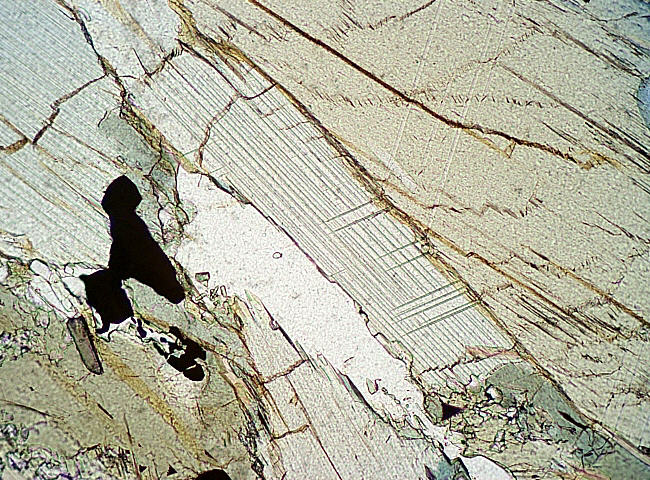 |
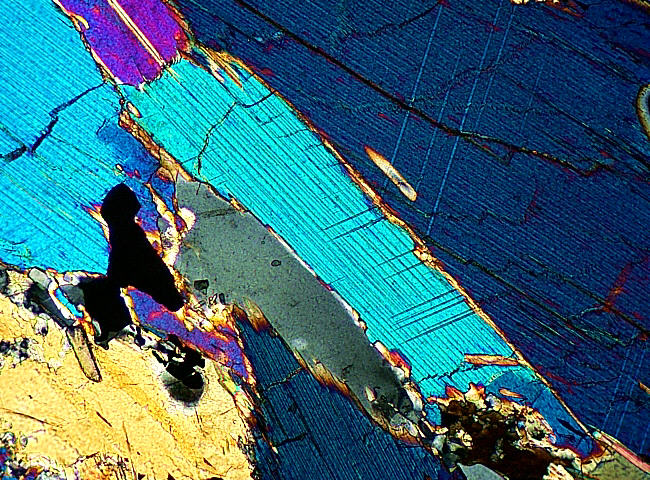 |
| Cummingtonite in a
hornblende–biotite–cummingtonite amphibolite. The cummingtonite is
almost colorless, but it has abundant green hornblende exsolution
lamellae that are on irrational planes approximately parallel to {100}
and {001}. Like most monoclinic amphiboles, birefringence is in the
lower second order. Plane/cross-polarized light, field width is 1.2 mm. Q-603C |
普通角閃石黒雲母カミングストン閃石角閃岩中のカミングストン閃石.カミングストン閃石はほぼ無色で,100と001の方向にほぼ平行な,よく道理がわからない板上の,多くの緑色の普通角閃石離溶ラメラを包有する.多くの単斜晶系の角閃石と同じく,複屈折は低い2次のオーダー. PPL/XPL,視野幅1.2mm |
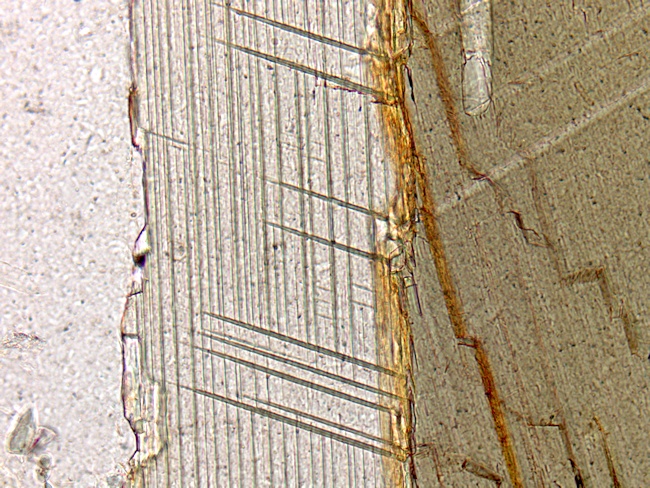 |
|
| Cummingtonite in a
hornblende–biotite–cummingtonite amphibolite. Close-up view of the
hornblende exsolution lamellae in cummingtonite, coming out on the two
irrational planes approximately parallel to {100} and {001}. Some
colorless cummingtonite exsolution lamellae can be seen in hornblende to
the right of the cummingtonite. Plane-polarized light, field width is 0.3 mm. Q-603C |
普通角閃石黒雲母カミングストン閃石角閃岩中のカミングストン閃石.カミングストン閃石中の普通輝石離溶ラメラのクローズアップ.100と001にほぼ平行な2つのイレイショナルな平面が明らかになる.幾つかの無色のカミングストン閃石の離溶ラメラも,右の角閃石中に見える. PPL,視野幅0.3mm |
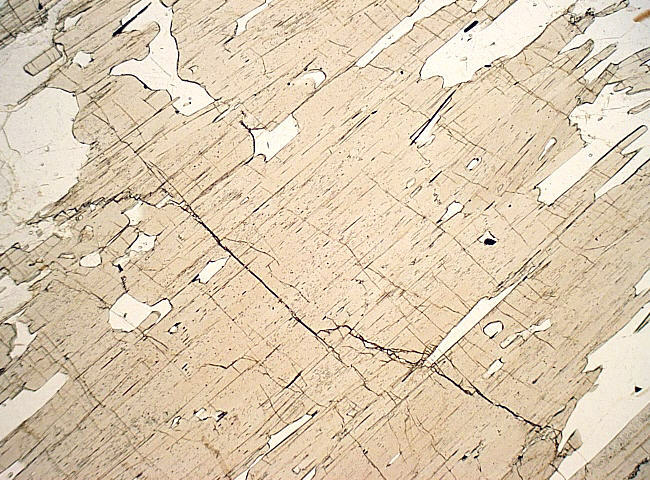 |
 |
| Gedrite in a
gedrite–cordierite–biotite gneiss. Gedrite colors range from colorless
to gray to green to brown. Gedrite is commonly associated with aluminous
minerals like cordierite, garnet, staurolite, and aluminosilicates, as
well as with other amphiboles. Anthophyllite is another, less aluminous
orthoamphibole, separated from gedrite by a solvus defined principally
by Na and Al content. Gedrite has lower birefringence than the
monoclinic amphiboles, typically in the upper 1st order. Plane/cross-polarized light, field width is 6 mm. IMA86-G2-1 |
ゲドライト菫青石黒雲母片麻岩中のゲドライト(礬土直閃石,ゼードル閃石).ゲドライトの色は無色から灰色,緑,茶色におよぶ.ゲドライトは菫青石,柘榴石,十字石,そしてアルミナ珪酸塩のようなアルミナ鉱物と共存する.直閃石は他方,アルミナに乏しい斜方角閃石である.主にNaとAl成分で定義されるソルバスによって,ゲドライトと区別される.ゲドライは単斜角閃石より低い低次1次の複屈折を持つ. PPL/XPL,視野幅6mm |
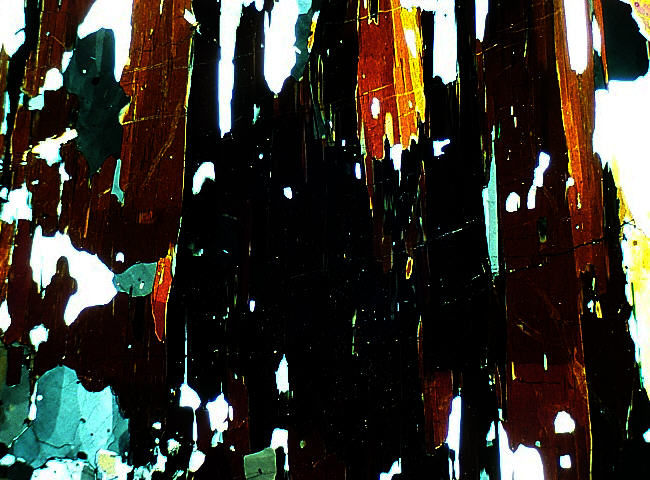 |
|
| Gedrite in a gedrite–cordierite
gneiss. Because gedrite is orthorhombic, crystals have extinction
parallel to their lengths. The orange crystal in the image immediately
above is here rotated 45° counterclockwise to extinction. Cross-polarized light, field width is 6 mm. W95 |
ゲドライト菫青石片麻岩中のゲドライト.ゲドライトは斜方晶系なので,その長軸方向に対して直消光を示す.画像ですぐ上にあるオレンジの鉱物はここで半時計周りに45度で消光する. XPL,視野幅6mm |
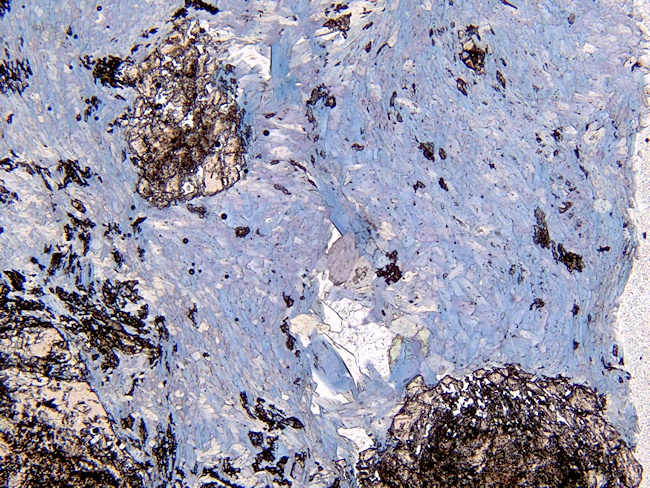 |
 |
| Glaucophane in a blueschist.
Glaucophane is characteristically pleochroic in shades of blue and
purple. This glaucophane is somewhat zoned, with pale cores and darker,
more Fe3+-rich rims. As with most monoclinic amphiboles, glaucophane has
birefringent colors in the lower second order. Plane/cross-polarized light, field width is 1.2 mm. C15 |
青色片岩の藍閃石.藍閃石は青と紫の影を示す多色性で特徴づけられる.この藍閃石は淡色の核とややFe3+に富む暗い縁の部分にややゾーニングされている.単斜晶系のおおくの角閃石と同じように,藍閃石は低次の2次の複屈折を持つ. PPL/XPL,視野幅1.2mm |
| Pyroxenes |
|
 |
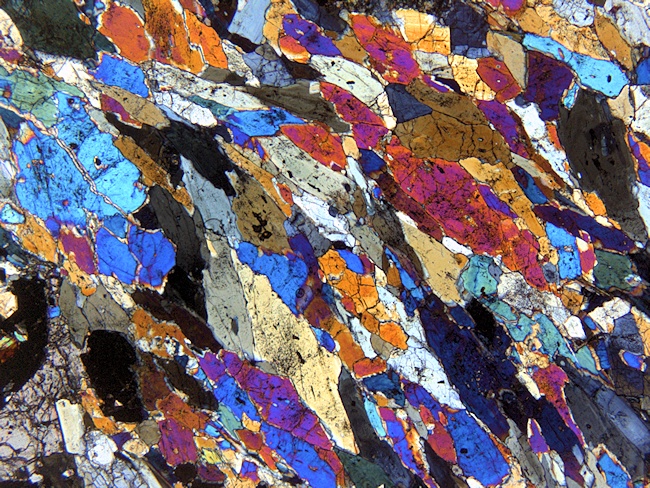 |
| Omphacite in an eclogite.
Omphacite is an Na–Ca–Mg–Al pyroxene, and holds the albite component in
this feldspar-free, high-pressure, low-temperature metamorphic rock.
Omphacite is pale green and slightly pleochroic. Like most
clinopyroxenes, omphacite has lower second order birefringence. Plane/cross-polarized light, field width is 1.2 mm. IG16-36 |
エクロジャイト中のオンファス輝石.オンファス輝石はNa–Ca–Mg–Al輝
石で,この斜長石を持たない低温高圧の変成岩で斜長石成分を保っている.オンファス輝石は淡緑色で,わずかに多色性を持つ.多くの単斜輝石と同じようにオ
ンファス輝石は低次の2次の複屈折を示す.
PPL/XPL,視野幅1.2mm |
| Sheet silicates |
|
 |
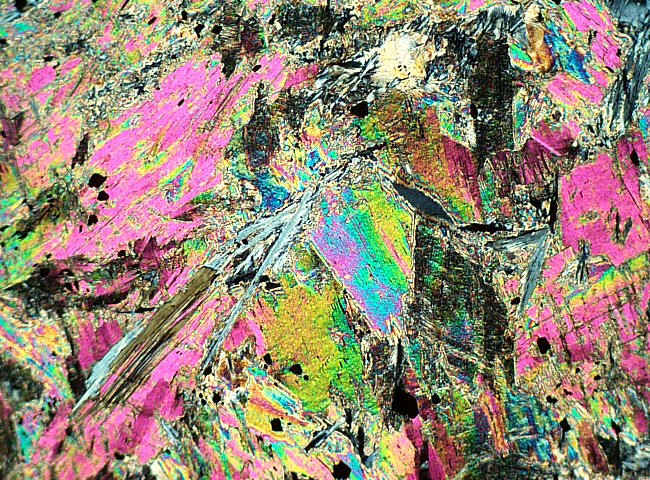 |
| Talc in a soapstone
(metamorphosed harzbergite). Talc is colorless and resembles muscovite
or colorless phlogopite, but is much softer. In hand specimen the two
are easy to tell apart because of the soapy feel of talc. Plane/cross-polarized light, field width is 3 mm. 4.6.84A |
ソープ石(変成したハルツバージャイト)の滑石.滑石は無色で白雲母や無色の金雲母に似るがそれより柔らかい.手持ちの標本では2つは用意に見分けられる.滑石は席巻のような感触で. PPL/XPL,視野幅3mm |
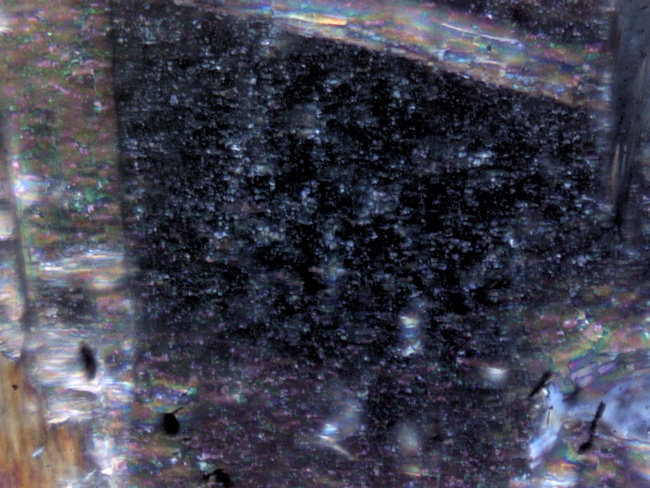 |
|
| Talc in a soapstone
(metamorphosed harzbergite). This talc crystal has been rotated to
extinction, but there are many small areas in the central grain that are
not extinct because of surface damage caused by the thin section
grinding process. The micas and calcite have this surface damage effect
too, but not so strongly. Cross-polarized light, field width is 0.3 mm. 4.6.84A |
ソープ石(変成したハルツバージャイト)の滑石.この滑石の結晶は消光角に回転されている.しかし中央部の粒には消光していないものがあり,それは薄片製作中の表面のダメージによるものである.雲母と方解石にも同様の表面のダメージがあるが,それはそれほど強くない. XPL,視野幅0.3mm |
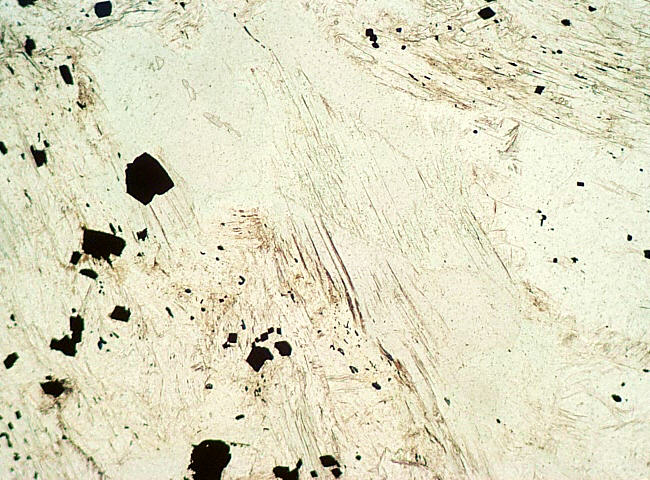 |

|
| Antigorite in a soapstone
(metamorphosed harzbergite). Antigorite is a serpentine mineral that is
platy, unlike fibrous asbestos. It is typically colorless to pale green,
and in some ways resembles chlorite. Antigorite commonly has anomalous
lower first order birefringence, like chlorite. Unlike chlorite,
however, it can have both anomalous Berlin blue and anomalous brown
interference colors in different orientations. Low birefringence
chlorite, in contrast, is either almost entirely anomalous blue
(Fe-rich), anomalous brown (Mg-rich), or anomalous violet (intermediate
composition). The anomalous colors are caused by high dispersion of the
2V. Plane/cross-polarized light, field width is 1.2 mm. 4.6.84A |
ソープ石中のアンチゴライト.アンチゴライトは蛇紋岩鉱物で,それは繊維状のア
スベストとは異なり板状である.典型的には無色から淡緑色で,幾つかの意味で緑泥石と似ている.アンチゴライトは通常,異常なほど低い1次の複屈折を持
つ.しかしながら緑泥石とは異なり,異なる方向でベルリン青と茶色の異常干渉色の両方を持つことができる.低い複屈折の緑泥石は,逆に,鉄に富む青い異常
干渉色か,Mgに富む茶色の異常干渉色か,中間組成の紫の異常干渉色のいずれかしか持たない.これらの異常干渉色は2Vの高い分散による. PPL/XPL,視野幅1.2mm |
| Epidote group |
|
 |
 |
| Epidote in an
epidote–amphibolite facies basaltic rock. Epidote is the term for the
optically negative, high birefringence Al-Fe3+ epidote, and is the most
common epidote type. It has parallel extinction relative to its usual
long crystal dimension (the b direction), but inclined excinction,
looking down b relative to its {001} cleavage. Although commonly light
yellow-green in thin section, it may be colorless. Its interference
colors commonly seem anomalously bright compared to pyroxenes, possibly a
result of the high dispersion of the 2V. Plane/cross-polarized light, field width is 1.2 mm. NOR-116 |
緑簾石角閃岩相の玄武岩質岩の緑簾石.緑簾石は光学的に負の高い複屈折を持つ,Al-
Fe3+緑簾石がもっとも一般的なタイプである.通常結晶の長い方向(b方向)に平行な消光を示すが,しかし001へき開とは相対的なb方向を見下ろすよ
うな斜消光である.淡い黄緑色が普通であるが,無色の場合もある.干渉色は輝石と比較して,異常なほど派手である.それは2Vの高い分散の結果と思われ
る. PPL/XPL,視野幅1.2mm |
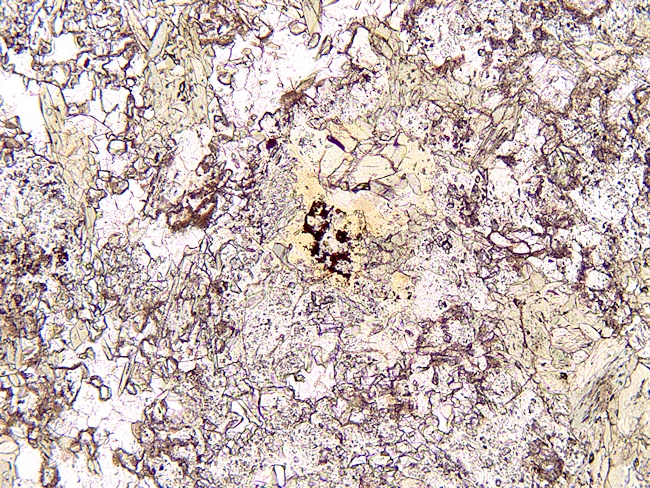 |
 |
| Clinozoisite in an Mg-rich
epidote amphibolite facies basaltic rock. Although clinozoisite is
usually colorless, here it is pleochroic colorless to pale-yellow.
Clinozoisite is optically positive, in contrast to epidote, and has
lower birefringence. In cross-polarized light the birefringence is
zoned, the result of variable Fe3+ content. The interference colors of
clinozoisite are anomalous, ranging from anomalous first order Berlin
blue and brown for Fe-poor varieties, to anomalous first order lemon
yellow for Fe-rich ones. The anomalous interference colors are the
result of strong dispersion of the 2V. Plane/cross-polarized light, field width is 1.2 mm. NOR-281 |
Mgに富む緑簾石角閃岩相の玄武岩質岩石中のクリノゾイサイト.通常クリノゾイ
サイトは無色である,ここでは無色から淡黄色の多色性がある.クリノゾイサイトは,緑簾石とは反対に光学的には正で,低い複屈折を持つ.XPLでは複屈折
はFe3+成分の結果として,ゾーニングされる.クリノゾイサイトの干渉色は鉄の乏しいときは,異常な1次のベルリン青から茶色で,鉄が富むと異常な1次
のレモン黄色に変化する.異常な干渉色は,2Vの強い分散の結果である. PPL/XPL,視野幅1.2mm |
| Oxides |
酸化物 |
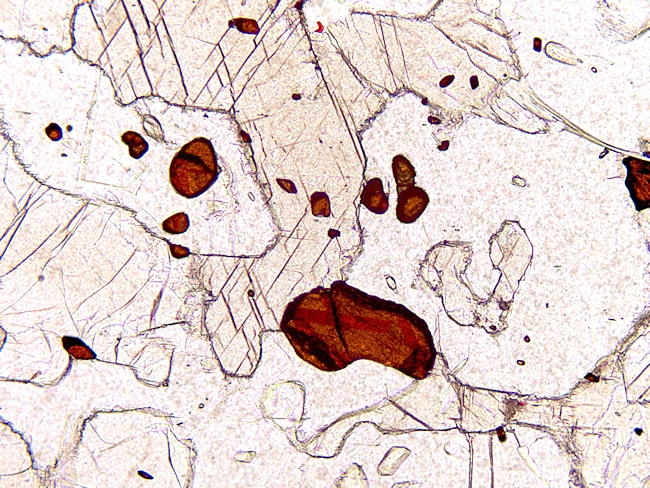 |
 |
| Rutile in a cordierite–gedrite
gneiss. Rutile is characteristically deep yellow-brown or orange-brown,
with enormously high relief. It can accept limited amounts of uranium
and thorium into its structure, and can produce radiation halos that are
generally weaker than those surrounding zircon, allanite, or monazite
(no halos visible here). Rutile has very high birefringence, rarely
discernable because of the dark mineral color, and because the high
colors are mostly pastels, made invisible by the dark mineral color.
Birefringence is discernable on very thin edges or rutile fibers. Plane/cross-polarized light, field width is 1.2 mm. W95 |
菫青石ゲドライト片麻岩中のルチル.
ルチルは特徴的な深い黄茶色かオレンジ茶色で異常な高い屈折率を持つ.そしてそれは構造の中に,わずかながらウラニウムやトリウムを含みうるので,ジルコ
ンやアレナイト,モンザナイト(ここではハローは見られないが)を囲むものに比べると弱いハローを見せる場合がある.ルチルは高い複屈折を持っているが,
その暗い鉱物色のためにそれを確認できない.そしてその高い干渉色も多くは弱いため,鉱物の色で見えなくなっている.複屈折は繊維状の部分や薄い端でのみ
確認できる. PPL/XPL,視野幅1.2mm |
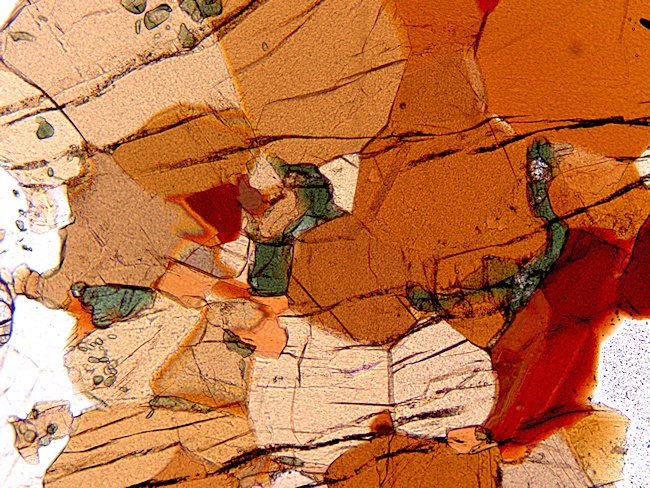 |
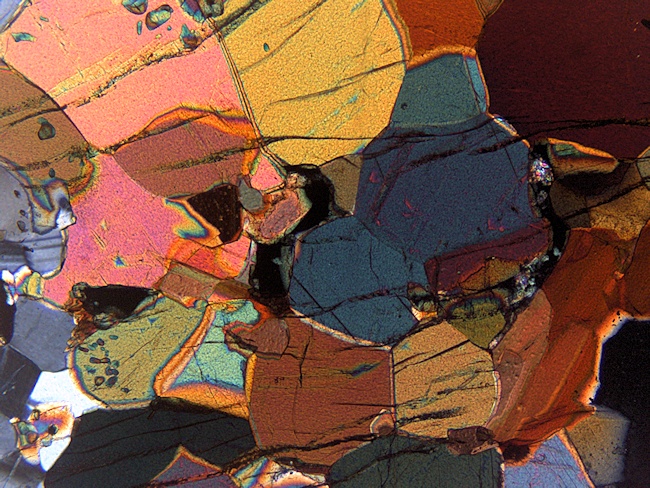 |
| Spinel in a hornblende–pyroxene
granulite. Spinel in common rocks is usually an intermediate Fe-Mg
solid solution, and so is usually green. It has very high relief. Spinel
is isotropic, but its green color distinguishes it from colorless to
pink garnet and colorless fluorite, and its high relief and color from
sodalite. Sodalite and spinel are unlikely to occur in the same rock
anyway. Plane/cross-polarized light, field width is 1.2 mm. TMW96-A4-A |
角閃石輝石グラニュライト中のスピネル.普通の岩石中のスピネルは
鉄とマグネシウムの中間的な固溶体である.したがって緑色を呈する.それは高い屈折率を持つ.スピネルは等軸晶系であるが,その緑色から無色やピンク色の
柘榴石,無色の蛍石と区別され,またその高い屈折率と色からソーダ石と区別される.ソーダ石とスピネルはいずれにせよ,同じ岩石に含まれることはまれであ
るが. PPL/XPL,視野幅1.2mm |